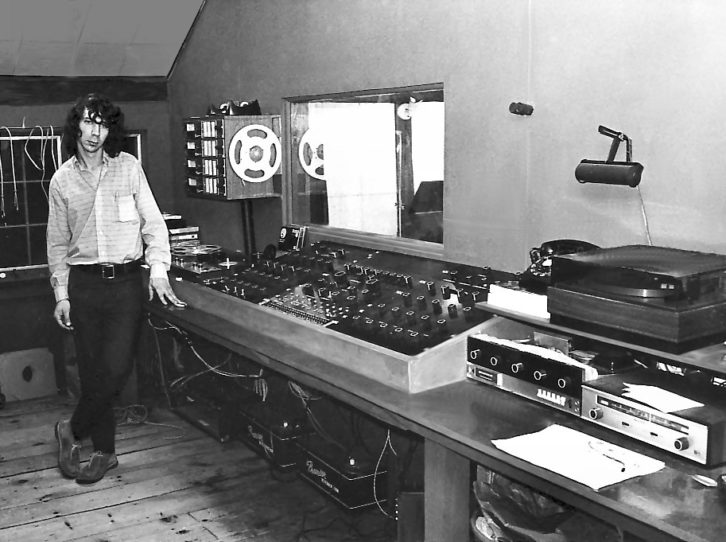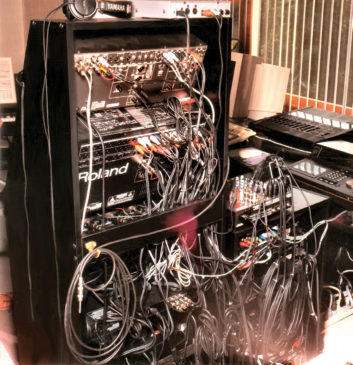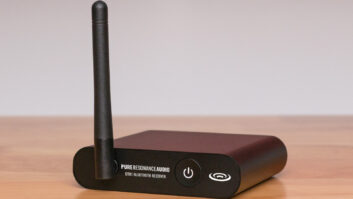The professional audio industry needs people like Ethan Winer—someone to stand up for science in an age of marketing run amok. Someone to actually run a bench test when a published spec or a long-accepted myth simply makes no sense. Someone who plays the cello with passion and excellence, same for guitar, who has designed and owned a number of recording studios, someone who has built his own console, effects boxes and null testers. Someone who has the courage to stand up and say that there is no demonstrable difference between a $19.95 RCA cable and a $700 hi-fi version, even when others try to shout him down.

Now 71 years old, having already lived a full lifetime in electronics design, recording and performance, with a side gig as an audio scientist, commentator, author, educator and mythbuster, Winer is still at it. You have most likely heard of him or read his writing over the years.
He was an avid contributor when the first electronic bulletin boards started appearing on CompuServe in the late 1970s, long before what we now call the Internet showed up, long before even the World Wide Web. And he’s just as active today, lending recording and technology insight, clarity and advice to pro audio and hi-fi forums daily, in addition to co-managing and running the acoustics company RealTraps from his comfortable home and workspace in Connecticut, where he lives with his four beloved rescued cats.
“I still spend several hours every day posting in forums and on Facebook Audio Groups,” Winer says. “It’s a big part of what I do, and it’s not for compensation or anything. I do it just to help other people. It’s that ham radio ethic from back in my childhood—a lot of people were nice to me and explained stuff.”
And yet, at the same time, his authority and search for truth can sometimes come across like the kid sitting next to you in Physics class who always had his homework in early, or the freshman in shop class who took the lawnmower engine apart, rebuilt it and improved it before you, the senior, could figure out how to test the spark plug to see whether it needed to be replaced. Respect, absolutely, but does he always have to be right?
Today, if any of the numerous well-accepted audio myths—especially those regarding noise, jitter, distortion and the like, or the ability to hear audible changes when the artifact sits 100 dB below the music—rear their heads in a pro audio forum, from gearslutz to proaudionetwork to more esoteric hi-fi online cliques, Winer is quick to offer a science-based explanation.
Posters will holler, “This is crazy, you can’t measure everything in audio.” To which he politely responds, “You absolutely can measure the fidelity of audio equipment.” He doesn’t lecture the poster; he’s gentle in his explanations and education. As he says, “Seat-of-the-pants empirical evidence trumps theory every time.”
He also has a rare talent for breaking down complex technological principles into simple terms so that they make sense. He knows what he knows, and he always has the science to back it up. His book, The Audio Expert, first published in 2012 and now in its second edition from Focal Press, is an excellent guide in detailing how and why audio systems work, from the internal workings of a compressor or equalizer to the acoustic response of the studio itself. His website is loaded with 40 years of articles, and now videos, of his test and measurement procedures.
GUITARS, TRANSISTORS & CIRCUIT BOARDS
Winer is not a “scientist,” and he is the first to point out that he has no advanced degrees, no Ph.D. from MIT. Everything he’s learned has been self-taught. At age 13 he built his first AM line transmitter and walked around the backyard listening to Bert Kaempfert’s Afrikaan Beat over and over on his portable radio, driving his parents crazy. He got a ham radio license around the same time.

At age 16, he got his first guitar, a Fender Mustang, after four years of playing the violin. Within a year he was building his own “fuzztones” for him and his friends. He loved The Ventures, and by age 18 “could play anything you heard on the radio.” He built the first of his three recording studios in his parents’ house. He played in rock ‘n’ roll bands. He loved music.
But his first love was electronics, so he’s also a guy who, with his friend Leo Taylor, brought a Hewlett-Packard computer into his second recording studio in 1971. He had also built the studio’s console. Later, in 1974, he and Taylor co-designed and built what he believes was the world’s first guitar synthesizer using a pitch-voltage converter.
“It worked on the high strings, it tracked perfectly,” Winer recalls. “But it danced around on the low strings, a common problem at the time. But at that point, I was definitely aware of the value of computers.”
From there, he went on to learn how to write in BASIC and assembly language before most people knew what a computer was. “When DAWs first came out—well, first it was really MIDI software—boy, I jumped on that,” he says. “My first personal computer was the Apple II+. I bought an 8-voice synthesizer board for it. This was around 1980, long before samples. That’s where I learned how to program computers.”
TEST & MEASUREMENT
By the 1980s Winer had built his third and final studio, The Recording Center, then the largest studio in Connecticut, and was working at an electronics company. On the side, he wrote a column for PC magazine, and by the mid-1980s he quit his job and formed a software consulting service. He would sell that company in 1992 to semi-retire and concentrate on music. He had started learning the cello at age 42.

But the overriding force in his life—that desire to know how things work—would never leave him. He built his “final recording studio” into his new home, and early in 2001 he and his friend/business partner Doug Ferrara sold all of their outboard recording equipment, and switched to using only a computer. The following year, he and Ferrara started the company RealTraps to manufacture high-performance acoustic treatment, reflecting his undying interest in acoustics and room performance as one of the largest “subjective” factors affecting how we perceive audio.
In the midst of all these varied careers, the desire to write, and to explain, how audio and electronics work led Winer to his fourth career, as a writer and educator. As a child, modeling his father, he was enamored of Consumer Reports, and how the editors would test a light bulb or refrigerator or television, and explain why one was better than another, regardless of price. In 1979, he began a series of articles for Recording Engineer/Producer magazine.

“I wrote pieces on parametric equalizers and how they work, distortion analyzers,” he recalls. “I wrote about how an oscilloscope works, how to build a crossover, showed a way to test absolute polarity with a microphone. My very first piece was about a modification to an Otari 2-track 1/4-inch machine, with a pre-distortion converter to reduce distortion from 3 percent to 1 percent. That’s when I really wanted to start sharing things. ‘Hey, you don’t have to spend a whole lot of money. Gear was expensive back then! Handmade and expensive. Much of my need to learn how things work was driven by the fact that I had no money! [Laughs]. I wanted to show others a way that they could improve the performance of their gear.”
Those 40 years of writings are all available on his retro-’90s-looking website, a functional design one might expect from a man who still doesn’t own a smartphone and turns off his computer each day at 5:30.
All of this knowledge, gleaned from a lifetime of curiosity and self-testing on his own work benches, came together in 2011 when he was approached by Focal Press after a presentation labeled “AES Audio Myths.” That turned into 11 months of straight writing and editing, which in 2012 was published as The Audio Expert, now in its second edition at 808 pages, with 83 audio examples, 31 demo videos and five audio-related software programs on the book’s companion website.
“It’s written for people who want to understand audio at the deepest, most technical level, but without needing an engineering degree,” he says. “I show methods to test the audibility of distortion and other artifacts using your own listening system, while explaining why many common homemade tests are not valid. There’s plenty of myth-busting and consumerism, too. Understanding how audio gear works leads to smarter buying.”
The book is used at universities and recording schools around the country; it received universal praise following publication, including the following from Craig Anderton, the dean of all audio writers: “The book’s overall tone is saturated with the enthusiasm of someone who clearly loves the subject matter, and loves disseminating it to others. No matter how much you know about recording and audio, you’re sure to find material here that will add to your expertise.”
Even then, Winer couldn’t sit still. Last year, at age 70, he produced a video to show his new Null Tester in action, a device that compares any two signal wires and reveals their difference to a level below –110 dB. “The beauty of a null test is that it’s absolute and reveals all differences, including frequency response, noise, distortion, phase shift and every possible artifact whether known or unknown,” Winer says. “This is very important because it dispels the common belief that ‘Science doesn’t know everything people can hear,’ or that ‘some aspects of audio fidelity can’t be measured using sine waves and other standard test signals.’”

Companies that make high-end cables are not his biggest fans. That doesn’t bother Winer; what would bother him is if there was wrong information out there. He wants to know how things really work, and he believes that others want to know, too.
Winer has certainly earned his music and electronics respect. At the same time, he can be a bit wacky, with an offbeat sense of humor that permeates his website. Where else can you find a collection of favorite life adages and then just one click away a video of a stripper explaining acoustics?
Ethan Winer still has the energy and enthusiasm of that teenager who built his first fuzztone, and he remains a most interesting and curious member of this greater audio and recording family. The next time you see a post, or a detailed explanation of the internal workings of a compressor, stop to say hello. He will surely reply.







